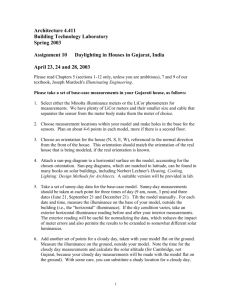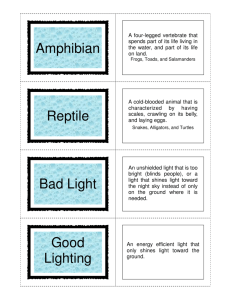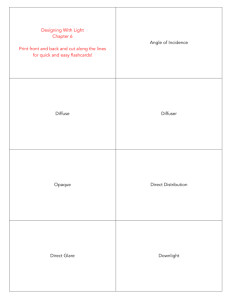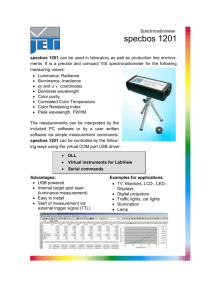Lighting Glossary
advertisement
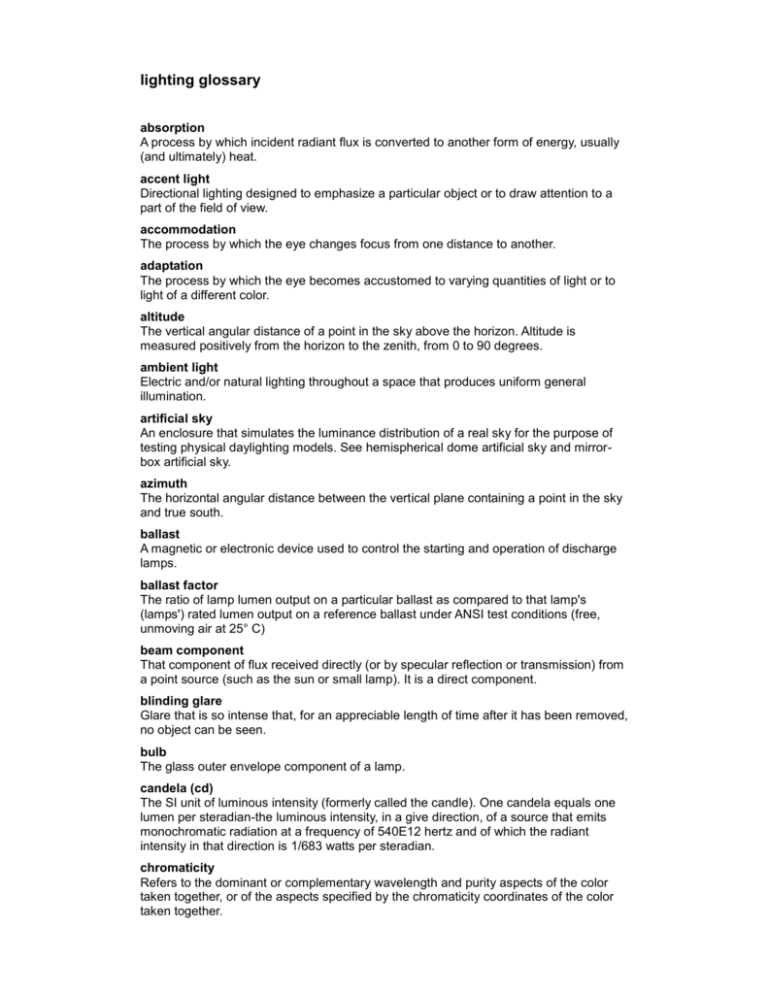
lighting glossary absorption A process by which incident radiant flux is converted to another form of energy, usually (and ultimately) heat. accent light Directional lighting designed to emphasize a particular object or to draw attention to a part of the field of view. accommodation The process by which the eye changes focus from one distance to another. adaptation The process by which the eye becomes accustomed to varying quantities of light or to light of a different color. altitude The vertical angular distance of a point in the sky above the horizon. Altitude is measured positively from the horizon to the zenith, from 0 to 90 degrees. ambient light Electric and/or natural lighting throughout a space that produces uniform general illumination. artificial sky An enclosure that simulates the luminance distribution of a real sky for the purpose of testing physical daylighting models. See hemispherical dome artificial sky and mirrorbox artificial sky. azimuth The horizontal angular distance between the vertical plane containing a point in the sky and true south. ballast A magnetic or electronic device used to control the starting and operation of discharge lamps. ballast factor The ratio of lamp lumen output on a particular ballast as compared to that lamp's (lamps') rated lumen output on a reference ballast under ANSI test conditions (free, unmoving air at 25° C) beam component That component of flux received directly (or by specular reflection or transmission) from a point source (such as the sun or small lamp). It is a direct component. blinding glare Glare that is so intense that, for an appreciable length of time after it has been removed, no object can be seen. bulb The glass outer envelope component of a lamp. candela (cd) The SI unit of luminous intensity (formerly called the candle). One candela equals one lumen per steradian-the luminous intensity, in a give direction, of a source that emits monochromatic radiation at a frequency of 540E12 hertz and of which the radiant intensity in that direction is 1/683 watts per steradian. chromaticity Refers to the dominant or complementary wavelength and purity aspects of the color taken together, or of the aspects specified by the chromaticity coordinates of the color taken together. clerestory That part of a building rising clear of the roofs or other parts, whose walls contain windows for lighting the interior. coefficient of utilization (CU) The ratio of lumens from a luminaire received on the work plane to the total quantity of lumens emitted by the lamps of that luminaire. color rendering index A measurement of the amount of color shift that objects undergo when lighted by a light source as compared with the color of those same objects when seen under a reference light source of comparable color temperature. CRI values generally range from 0 to 100. color temperature The absolute temperature of a blackbody radiator having a chromaticity equal to that of the light source (see correlated color temperature). cone A retinal receptor that dominates the retinal response when the luminance level is high and provides the basis for the perception of color. contrast The ratio of the luminance of an object to that of its immediate background. cosine law The law that the illuminance on any surface varies as the cosine of the angle of incidence. (The angle of incidence is the angle between the normal to the surface and the direction of the incident light.) cut-off angle The critical viewing angle beyond which a source can no longer be seen because of an obstruction (such as a baffle or overhang). dark adaptation The process by which the retina becomes adapted to a luminance of less than 0.01 footlamberts. daylight factor (DF) The ratio of daylight illumination at a given point on a given plane due to the light received directly or indirectly from a sky of assumed or known luminance distribution, to the illumination on a horizontal plane due to an unobstructed hemisphere of this sky, expressed as a percentage. Direct sunlight is excluded for both values of illumination. The daylight factor is the sum of the sky component, the external reflected component, and the internal reflected component. The interior plane is usually horizontal. If the sky condition is the C.I.E. standard overcast condition, then the DF will remain constant, regardless of absolute exterior illuminance. If used in conjunction with other than standard overcast conditions, the sky conditions should be specified. The term is also informally applied to the ratio of horizontal interior to exterior illuminance in the fenestration plane; under clear sky conditions, the DF remains constant only if the fenestration is completely diffusing (such as an ideal opalescent glass). diffusing (surface) Those surfaces and glazing that redistribute some of the incident flux by scattering in all directions. disability glare Glare resulting in reduced visual performance and visibility . Often accompanied by discomfort glare. discomfort glare Glare producing discomfort. Does not necessarily interfere with visual performance or visibility. efficacy A measure of the luminous efficiency of a radiant flux, expressed in lumens per watt as the quotient of the total luminous flux by the total radiant flux. For daylighting, this is the quotient of visible flux incident on a surface to radiant flux on that surface. For electric sources, this is the quotient of the total luminous flux emitted by the total lamp power input. emissivity/emittance The ratio of radiance (for directional emissivity) or radiant exitance (for hemispherical emissivity) of an element of surface on a temperature radiator to that of a blackbody at the same temperature. By Kirchoff's Law, for a given wavelength of the electromagnetic spectrum, emissivity of a surface equals its absorptivity (and is the reciprocal of its reflectivity). exitance The density of light reflecting from a surface at a point, measured in lumens per square foot (formerly "footlamberts"). It is determined by multiplying the footcandles striking a diffuse reflecting surface times the reflectance of that surface. fenestration Any opening or arrangement of openings (normally filled with glazing media) for the admission of daylight, including any devices in the immediate proximity of the opening that affect distribution (such as baffles, louvers, draperies, overhangs, light-shelves, jambs, sills, and other light-diffusing materials). fixture Informal substitute term for luminaire. fluorescent A discharge lamp in which a phosphor coating transforms ultraviolet energy into visible light. flux The time rate of flow. For example, volume per hour is the flux of a fluid. footcandle A standard measurement of illuminance, representing the amount of illuminance on a surface one foot square on which there is a uniformly distributed flux of one lumen. footlambert (fl) A unit of luminance equal to 0.3183010 candela per square foot, or to the uniform luminance of a perfectly diffusing surface emitting or reflecting light at a rate of one lumen per square foot, or to the average luminance of a surface emitting or reflecting light at that rate. An unobstructed sky of one footlambert uniform luminance contributes one footcandle of illuminance on a horizontal plane. fovea A small region at the center of the retina, subtending about two degrees and forming the site of the most distinct vision and greatest color discrimination. glare See direct glare, disability glare, discomfort glare, reflected glare. glare index A method of predicting the presence of discomfort glare due to daylighting. Factors affecting the glare index include the size and relative position of fenestration, sky luminance, and interior luminance. Most widely used in Europe, the glare index is similar to the index of sensation and the discomfort glare rating, which are used in North America for electric lighting applications. hue The attribute of a color that allows it to be classified as red, yellow, blue, and so on. IALD International Association of Lighting Designers IESNA Illuminating Engineering Society of North America illuminance The density of incident luminous flux on a surface; illuminance is the standard metric for lighting levels, and is measured in lux (lx) or footcandles (fc). incandescence The emission of visible electromagnetic radiation due to the thermal excitation of atoms or molecules. indirect sources Surfaces which, after being illuminated by other sources (direct sources such as the sun, sky, or electric light, or other indirect sources), have measurable luminance and, in turn, become sources themselves. infrared radiation Radiation with wavelengths too long to be perceived by the human eye (that is, longer than 0.77 microns) and less than 1,000 microns. Room IR is infrared radiation in the 7.78.0 micron region and typical of that radiated from surfaces near room temperature. inverse-square law The law stating that the illuminance at a point on a surface varies directly with the intensity of a point source, and inversely as the square of the distance between that source and that surface. irradiance (E) The density of radiant flux incident on a surface. isolux (isofootcandle) line A line plotted on any appropriate set of coordinates to show all the points on a surface where the daylight illuminance is the same. A series of such lines for various illuminance values is called an isolux (isofootcandle) diagram. lamp An electrically energized source of light, commonly called a bulb or tube. lamp lumen depreciation The decrease over time of lamp lumen output, caused by bulb wall blackening, phosphor exhaustion, filament depreciation and other factors. light Radiant energy that is capable of exciting the retina and producing a visual sensation. The visible portion of the electromagnetic spectrum (light) extends from about 0.38 to 0.77 microns. light loss factor (LLF) A factor used in calculating the illuminance after a given period of time and under given conditions. It takes into account temperature and voltage variations, lamp depreciation (of electric luminaries), dirt accumulation on luminaire and room surfaces, maintenance procedures and atmosphere conditions. Formerly called maintenance factor. light shelf A horizontal shelf positioned (usually above eye level) to reflect daylight onto the ceiling and to shield direct flare from the sky. lumen The quantity of luminous flux emitted within a unit solid angle (one steradian) by a point source with one candella intensity in all directions. lumen method A method of estimating the interior illuminance due to window daylighting at three locations within a room. Based on empirical studies, the use of this method is primarily limited to North America. luminaire A complete lighting unit, consisting of a lamp or lamps together with the components required to distribute the light, position the lamps, and connect the lamps to a power supply. Often referred to as a "fixture." luminaire dirt depreciation A multiplier used in lighting calculations to account for the reduction in illuminance produced by the accumulation of dirt on a luminaire. luminance The luminous intensity of a surface in a given direction per unit area of that surface as viewed from that direction; often incorrectly referred to as "brightness." lux (lx) The SI unit of illuminance equal to one lumen per square meter. matte surface Surface from which the reflection is predominantly diffuse, with or without a negligible specular component. monitor A raised section of roof that includes a vertically (or near-vertically) glazed aperture for the purpose of daylighting illumination. near infrared (solar infrared) The region of the electromagnetic spectrum between 0.77 to 1.4 microns. Most of the infrared solar radiation falls into this region. This near infrared (or solar IR) region is transmitted, absorbed, and reflected in a similar manner to visible light by most glazing and nonmetallic building materials. overcast sky A sky luminance distribution three times brighter near (C.I.E. Standard Condition) the zenith than at the horizon, as defined by a formula proposed by Moon and Spencer in 1942 and adopted by the Commission International de l'Eclairge in 1955 overhang A horizontal building projection, usually above a window, for the purpose of shading. photocell A device that measures the amount of incident light present in a space. peripheral vision The seeing of objects displaced from the primary line of site and outside of the central visual field. point method A method of estimating the illuminance at various locations in a building using photometric data. pupil The opening in the iris of the eye that admits light. radiant energy (radiation) Energy traveling in the form of electromagnetic waves. Measured in units of energy such as joules, ergs, or kilowatt-hours. refraction The process by which the direction of light changes as it passes obliquely from one medium to another in which its speed is different. reflectance The ratio of reflected flux to incident flux. retina A light-sensitive membrane lining the posterior part of the inside of the eye. rods Retinal receptors that respond to low levels of luminance but cannot distinguish hues. Not present in the center of the fovea region. room cavity ratio In lighting calculations, a measure of room proportion as determined by dimensions of length, width, and height. skylight A relatively horizontal glazed roof aperture for the admission of daylight. specular angle The angle of mirror reflection (angle of incidence equals angle of reflectance). specular reflection The process by which incident light is redirected at the specular (mirror) angle. specular transmission The process by which incident flux passes through a surface or medium without scattering. task light Light that is directed to a specific surface or area to provide illumination for visual tasks. ultraviolet radiation (uv) Any radiant energy within the wavelength range of 0.001 to 0.38 microns. veiling reflection Specular reflection superimposed upon diffuse reflection from an object that partially or totally obscures the details to be seen by reducing the contrast. Controlled by distributing the source over a larger area, relocating the source out of the reflected field of view, changing the task surface specular reflectance or tilt, or relocating the observer. visual acuity A measure of the ability to distinguish fine details. visual comfort probability (VCP) The rating of a lighting system expressed as a percentage of the people who, when viewing from a specified location and in a specified direction, will be expected to find it comfortable in terms of discomfort glare.
